Mao Shan: 9/23/2007 (Autumn Equinox)
China
[ Please read the intro to Taoist Mtns in China if you have not already ]
After a few days in Shanghai, we caught a train to the city of Nanjing, capital of the Jiangsu Province. We were startled by the overall size of every city in China, even the little towns are big cities with skyscrapers and pollution. We got a shabby room in a big hotel on a big street in the big city. After a yummy dinner on a crowded pedestrian-only street, lined with restaurants and snack stands, we found a taxi to take us to Maoshan the next morning.
The taxi driver was absolutely on time, and very friendly, despite that he did not speak a word of English, and we knew only one word in Chinese (hello). We drove East out of town through some agricultural land to the village at the base of Maoshan. We stopped at an odd communist memorial to some violent man on a horse.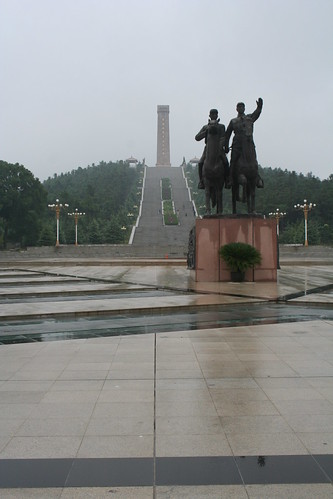 As we climbed up, the police/military men who sold us the tickets to see the memorial set off a racket of fireworks at the bottom. After this strange and somewhat disturbing visit, the taxi driver took us on to the real Maoshan starting point, a temple on the opposite side of the mountain.
As we climbed up, the police/military men who sold us the tickets to see the memorial set off a racket of fireworks at the bottom. After this strange and somewhat disturbing visit, the taxi driver took us on to the real Maoshan starting point, a temple on the opposite side of the mountain.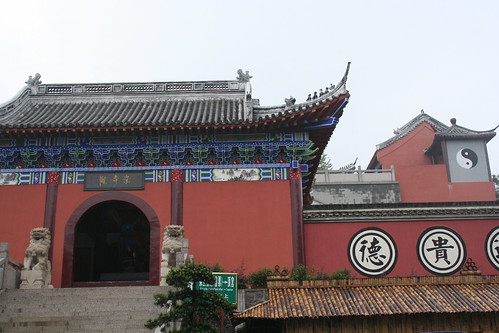
Maoshan is the "first land of blessing", and the "eighth world of caves" for Taoism. It has been a Taoist center since the beginning of formal Taoism during the end of the Han Dynasty (206 BC-AD 220). The mountain used to be covered with temples, hermitage sites, and shrines, but much was destroyed and some has since been rebuilt. Giuliano Bertueciolo, an Italian Academic who studied Taoism, visited Maoshan in 1974 studying its critical role in the history of Taoism. He published an article "the Memory of Mt. Maoshan" in the Journal of Oriental Studies describing the prosperity and history of the Temples on Maoshan. In 1985, he returned to Maoshan and published another article depicting the decline of Maoshan and Taoism during China's Cultural Revolution.
The Temple at the bottom of the pilgrimage path has been newly rebuilt (by the Cable Car Company!), and felt rather plastic, even Disneyland-ish. Like each of the sacred mountains we visited in China, it was almost more oriented toward the Chinese tourist, rather than to anyone coming for religious or spiritual purpose. We visited the temple, then started up the mountain on foot (we did not take the cable car).
The trail through the dense underbrush was hot, humid, and devoid of other hikers. We were just getting uncomfortably sweaty when the trail forked. On the left was the trail down to the caves! Despite the purpose of going up, we had to go down... it got spooky. We passed a few shrines, and then a big, new, statue of an Ox coming out of a cave stopped us.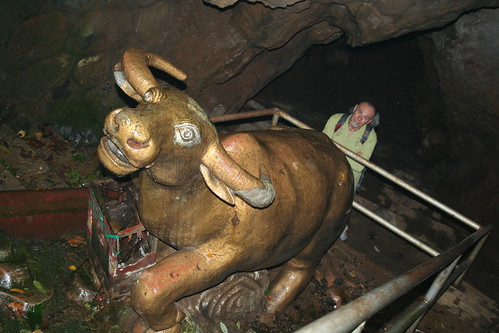 Whatever had been the 8th world of caves was now more like the "It's a small world after all" ride. We headed back up to the main trail.
Whatever had been the 8th world of caves was now more like the "It's a small world after all" ride. We headed back up to the main trail.
Soon, we noticed lines of embedded pebbles in the cement pathway. Ah, yes, these are the various line combinations that make up the I Ching or "Book of Changes", the ancient Chinese oracle. We followed the path of the I Ching until it brought us to another Temple. This one was the most religiously genuine place on the mountain.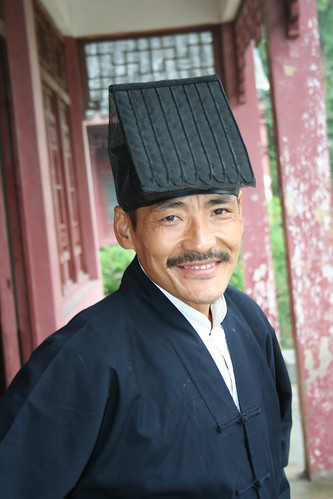 A monk greeted us at the door, and led us in to where we bowed as he struck a musical bowl. Then he walked us through the building to some beautiful gardens and pond where the trail to the summit continued.
A monk greeted us at the door, and led us in to where we bowed as he struck a musical bowl. Then he walked us through the building to some beautiful gardens and pond where the trail to the summit continued.
Just up from the temple, is a parking lot where everyone else drives to to begin the walk.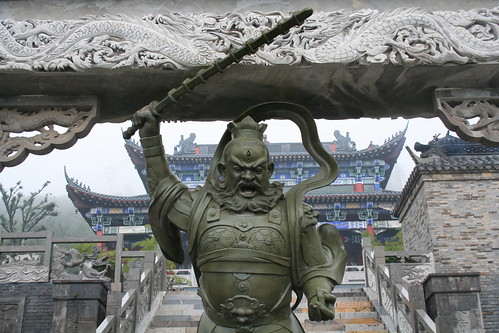 We walked through and up a long set of stairs to another temple, stopping to examine a set of sculptures; the animals of the Chinese zodiac. At this temple, a group of Taoist monks were playing traditional music and singing.
We walked through and up a long set of stairs to another temple, stopping to examine a set of sculptures; the animals of the Chinese zodiac. At this temple, a group of Taoist monks were playing traditional music and singing.
After this, the mountain trail was mostly stone stairs.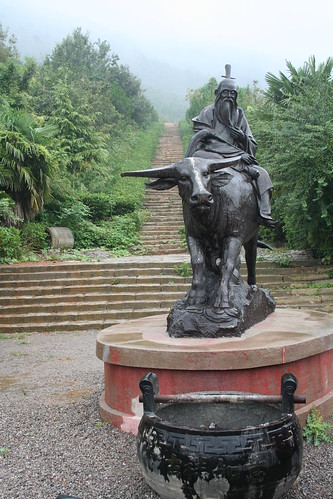 It was interrupted by a newly built, and horrible, wax museum of various forms of torture and demons. We practically ran through it to get to the trail again. The stone steps became wooden planks on wobbly chains until we arrived at a small pagoda. Here two people were playing cards and smoking cigarettes and selling small heart shaped locks for couples or family to lock onto the chains. We bought one, engraved "R+S", and locked it on.
It was interrupted by a newly built, and horrible, wax museum of various forms of torture and demons. We practically ran through it to get to the trail again. The stone steps became wooden planks on wobbly chains until we arrived at a small pagoda. Here two people were playing cards and smoking cigarettes and selling small heart shaped locks for couples or family to lock onto the chains. We bought one, engraved "R+S", and locked it on.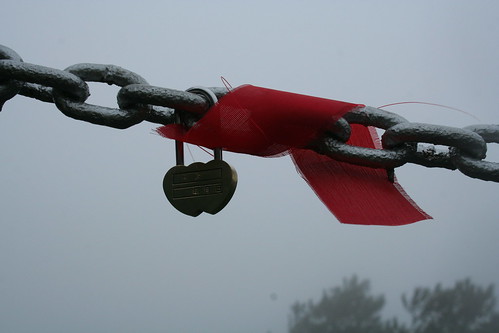
At the summit was another temple, but we did not go into it. We sat in another small pagoda and watched other tourists and people at the souvenir stands through the swirling mountaintop mist.
During this day, our first sacred mountain climb in China, I only caught glimpses of the real history and power of this place. I want to give this "first land of blessing" a blessing. I hope that the power of this historical sacred site can be recovered from the anti-religious drape of Communist China. Blessings to Maoshan.
China
[ Please read the intro to Taoist Mtns in China if you have not already ]
After a few days in Shanghai, we caught a train to the city of Nanjing, capital of the Jiangsu Province. We were startled by the overall size of every city in China, even the little towns are big cities with skyscrapers and pollution. We got a shabby room in a big hotel on a big street in the big city. After a yummy dinner on a crowded pedestrian-only street, lined with restaurants and snack stands, we found a taxi to take us to Maoshan the next morning.
The taxi driver was absolutely on time, and very friendly, despite that he did not speak a word of English, and we knew only one word in Chinese (hello). We drove East out of town through some agricultural land to the village at the base of Maoshan. We stopped at an odd communist memorial to some violent man on a horse.
 As we climbed up, the police/military men who sold us the tickets to see the memorial set off a racket of fireworks at the bottom. After this strange and somewhat disturbing visit, the taxi driver took us on to the real Maoshan starting point, a temple on the opposite side of the mountain.
As we climbed up, the police/military men who sold us the tickets to see the memorial set off a racket of fireworks at the bottom. After this strange and somewhat disturbing visit, the taxi driver took us on to the real Maoshan starting point, a temple on the opposite side of the mountain.
Maoshan is the "first land of blessing", and the "eighth world of caves" for Taoism. It has been a Taoist center since the beginning of formal Taoism during the end of the Han Dynasty (206 BC-AD 220). The mountain used to be covered with temples, hermitage sites, and shrines, but much was destroyed and some has since been rebuilt. Giuliano Bertueciolo, an Italian Academic who studied Taoism, visited Maoshan in 1974 studying its critical role in the history of Taoism. He published an article "the Memory of Mt. Maoshan" in the Journal of Oriental Studies describing the prosperity and history of the Temples on Maoshan. In 1985, he returned to Maoshan and published another article depicting the decline of Maoshan and Taoism during China's Cultural Revolution.
The Temple at the bottom of the pilgrimage path has been newly rebuilt (by the Cable Car Company!), and felt rather plastic, even Disneyland-ish. Like each of the sacred mountains we visited in China, it was almost more oriented toward the Chinese tourist, rather than to anyone coming for religious or spiritual purpose. We visited the temple, then started up the mountain on foot (we did not take the cable car).
The trail through the dense underbrush was hot, humid, and devoid of other hikers. We were just getting uncomfortably sweaty when the trail forked. On the left was the trail down to the caves! Despite the purpose of going up, we had to go down... it got spooky. We passed a few shrines, and then a big, new, statue of an Ox coming out of a cave stopped us.
 Whatever had been the 8th world of caves was now more like the "It's a small world after all" ride. We headed back up to the main trail.
Whatever had been the 8th world of caves was now more like the "It's a small world after all" ride. We headed back up to the main trail.Soon, we noticed lines of embedded pebbles in the cement pathway. Ah, yes, these are the various line combinations that make up the I Ching or "Book of Changes", the ancient Chinese oracle. We followed the path of the I Ching until it brought us to another Temple. This one was the most religiously genuine place on the mountain.
 A monk greeted us at the door, and led us in to where we bowed as he struck a musical bowl. Then he walked us through the building to some beautiful gardens and pond where the trail to the summit continued.
A monk greeted us at the door, and led us in to where we bowed as he struck a musical bowl. Then he walked us through the building to some beautiful gardens and pond where the trail to the summit continued.Just up from the temple, is a parking lot where everyone else drives to to begin the walk.
 We walked through and up a long set of stairs to another temple, stopping to examine a set of sculptures; the animals of the Chinese zodiac. At this temple, a group of Taoist monks were playing traditional music and singing.
We walked through and up a long set of stairs to another temple, stopping to examine a set of sculptures; the animals of the Chinese zodiac. At this temple, a group of Taoist monks were playing traditional music and singing.
After this, the mountain trail was mostly stone stairs.
 It was interrupted by a newly built, and horrible, wax museum of various forms of torture and demons. We practically ran through it to get to the trail again. The stone steps became wooden planks on wobbly chains until we arrived at a small pagoda. Here two people were playing cards and smoking cigarettes and selling small heart shaped locks for couples or family to lock onto the chains. We bought one, engraved "R+S", and locked it on.
It was interrupted by a newly built, and horrible, wax museum of various forms of torture and demons. We practically ran through it to get to the trail again. The stone steps became wooden planks on wobbly chains until we arrived at a small pagoda. Here two people were playing cards and smoking cigarettes and selling small heart shaped locks for couples or family to lock onto the chains. We bought one, engraved "R+S", and locked it on.
At the summit was another temple, but we did not go into it. We sat in another small pagoda and watched other tourists and people at the souvenir stands through the swirling mountaintop mist.
During this day, our first sacred mountain climb in China, I only caught glimpses of the real history and power of this place. I want to give this "first land of blessing" a blessing. I hope that the power of this historical sacred site can be recovered from the anti-religious drape of Communist China. Blessings to Maoshan.
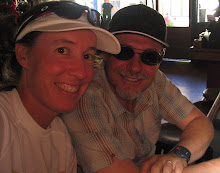
1 comment:
Would You care to explain in more details where one can find this Mount Mao? Because there are a few named like this in China.
Post a Comment